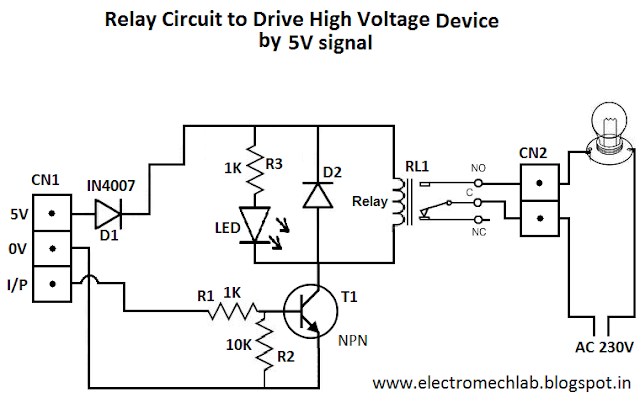Sometimes we need to control or drive a
high voltage and heavy current load by a small voltage signal.
For example, if you want to control water
motor with your microcontroller output. We know that microcontroller gives only
5v output which is not sufficient to drive a heavy motor.
This circuit, about which this post is, is
very-very useful for electronics engineer and hobbyist.
So pay attention!
For this circuit the material we need
is…
General Purpose PCB - 5x5 cm.
Transistor KN 2222A (TO-92) - 1 No.
Relay 5V – 1 No.
1K/0.250W – 2 Nos.
10K/0.250W – 1 No.
IN4007 – 2 Nos.
LED 3mm – 1 No.
Connector – 4 Nos.
Few wires.
Tools.
Concept: Weak
signal triggers the transistor and transistor acts as a switch for the relay.
You can use any relay of 12V, 24V, 5V etc.
but we have to consider power supply or battery we will use.
Since 5V power supply is easily available
and 9V battery can also be used for 5V output (after using 7805 regulator if
needed).
So I am using 5V relay.
Transistor 2222 is used, here, as a switch
to drive the relay OR you can use any other NPN transistor.
Circuit description:
5V is connected to the one end of the relay
and transistor collector is connected to the other end of the relay.
So both
the ends of the relay have been connected.
Collector of transistor is connected.
Emitter of transistor is connected to the
0V (GND).
Now base of transistor is pulled down with
the help of 10K resistor, to avoid floating issue of its base pin.
One end of 1 Kohm resistor is connected to
the base, and input signal (driving signal) will be applied to other end of
1Kohm resistor.
Small signal on the base of transistor will
conduct the transistor and coil of relay will be actuated and contacts of relay
will swap their mode.
COM (common) will connect to N/O.
I’ve connected one diode D2 across the
relay coil. It is working here a free wheel diode. It can save the relay from
being damaged.
About free-wheel diode I will discuss in
another post.
I would like to mention here, whenever you connect any
diode in circuit BE ALERT!, you must be very well aware about their polarity.
NEVER connect diode in wrong polarity.
I have connected One LED to show the status of relay,
when relay is actuated, LED will glow, otherwise OFF.
1Kohm resistor is used in series with the LED.
I have added one IN4007 (I had only this, that’s why),
to positive line, to save this circuit from reverse power supply applied to the
circuit.
Now if you connect reverse voltage then circuit will NOT DAMAGE.
Happy?
I tested this circuit with a 230Vac bulb, you can also
try this.

